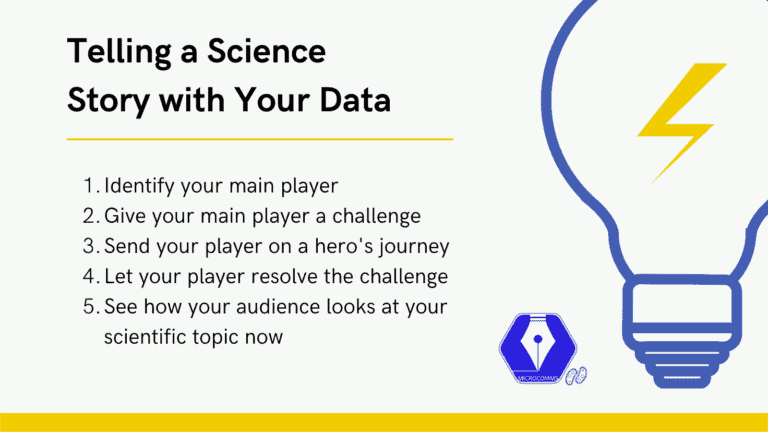As a scientist you produce a lot of data. Data about your research questions, from experiments, proving a hypothesis or proving it wrong.
But these data don’t mean much to people outside of scientific expert fields. And yet, scientists are supposed to talk about research and communicate findings and great results.
From research in science communication, we know that if you throw data at people (scientist or not!), they won’t remember any of them. You need to pack these data into stories. Such a story can be about you finding the answer to a research question or can be the adventures of the players from your research project.
Improve your science communication skills by engaging with your audience
While it is interesting in the scientific field to talk about the successes and failures of your experiments, to non-researchers they might not mean much. For someone from outside of your expert field, it is more important to learn about the actual results of your experiments and how these can help their lives.
For them to understand this, you need to wrap your data into a fun and entertaining story about a hero and its journey. This approach helps you improve your science communication skills while your audience is able to learn about your research project.
Here, I want to help you find the story in your data, identify your hero and give it personality and character so that your audience can better understand your research project. Generally, the concept of storytelling (not only in science communication!) boils down to two main concepts:
- Give your player personality and a struggle
- Let your player DO something to get out of this struggle
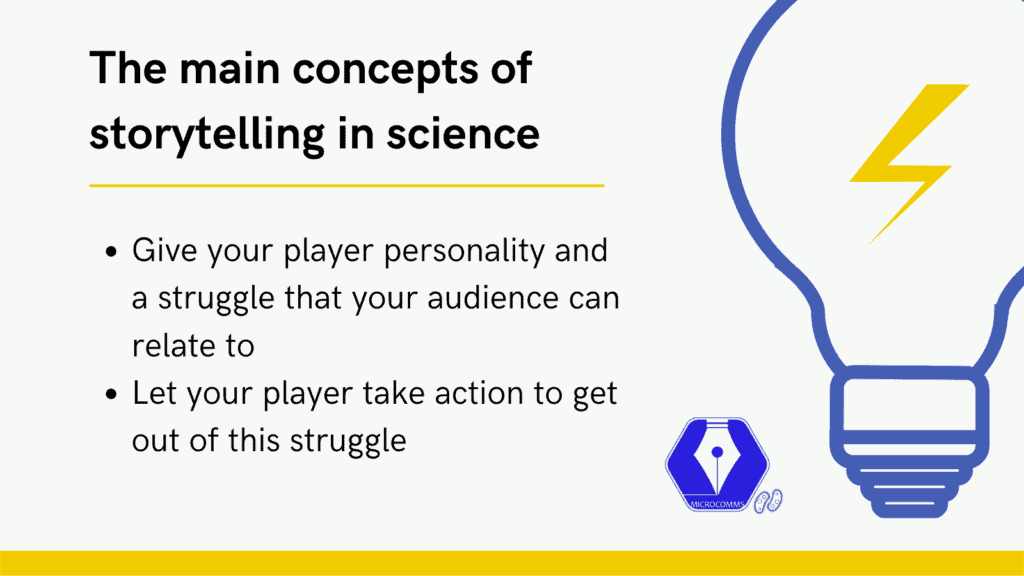
Let’s look at how you can improve your science communication skills with these approaches.
Start your science story by giving your player character
In your research, you likely focus on one main component: a certain bacterium, a protein, cancer cells or the immune system. Just as this component is the focus of your research question, it should be the main player in your science story.
So, the whole story should focus on the character of your main player and a struggle that it is trying to solve. Think about the most exciting stories you heard or told. They are usually about someone facing an issue or solving a problem. To engage your audience, you need to do the same with your player.
The struggle is most likely the research question that you are focussing on. And this research question not only drives your research project but also your science communication story.
The idea is to re-formulate your research question into an accessible struggle for people to identify with.
Struggles your player could face in your science story
- You are researching how bacteria are adapting to low-nutrient environments. Your main player is your bacterium and its struggle is that it is hungry and looking for food.
- You are researching a signalling cascade involving on- and off switching of proteins. Your main player is your protein and its character is that sometimes it feels like being active but sometimes it is lazy and doesn’t want to work.
- You are researching metastasis of breast cancer. Your main player is the cancer cell that wants to explore new locations to find better places to live.
- You are researching how the immune system fights SARS-CoV-2. Your main player is the immune system – or specific parts of it – and its goal is to protect the human body from dangerous invaders.
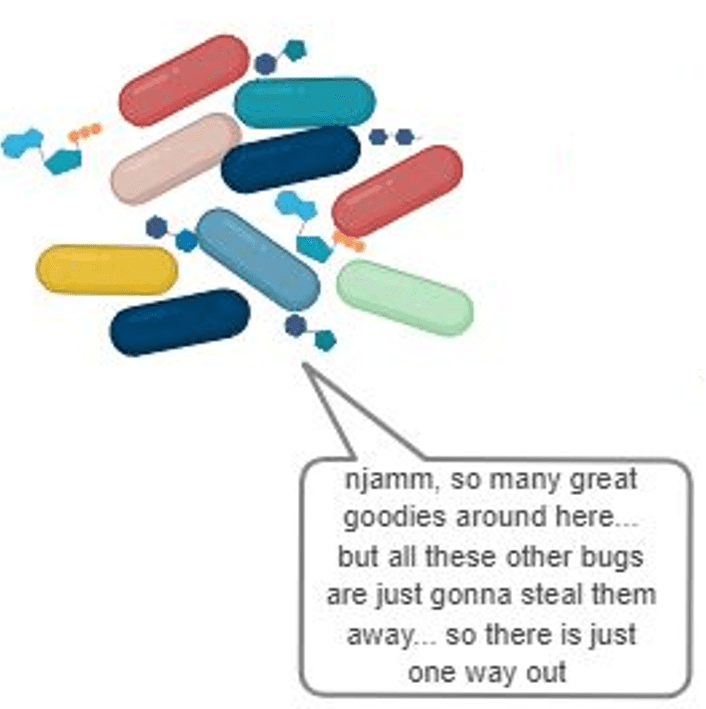
These struggles are real-life struggles. Everyone knows how it feels to be hungry, to sometimes feel active or not, to explore new locations or to protect something from someone.
So, everyone can relate to these stories and thus to the scientific problem you are trying to solve. This already helps your audience understand what your research is about and you can hook them easily. Next, we will send your player on a journey and use storytelling to reveal your actual science story.
Use storytelling and send your player on a scientific hero’s journey
You might have heard of the hero’s journey in books like Harry Potter or movies likes Matrix. It is about the protagonist finding its calling, being faced with a struggle and having to overcome these struggles.
In science communication, you can use this hero’s journey to tell your science story. You can send your play on a similar journey by talking about the struggles it is facing. Make the audience understand just HOW uncomfortable the situation is for your player, explain its scientific background and where the struggle comes from.
Now, you send your player on a journey and tell the story of how it overcomes these struggles. It usually takes an action to solve the issue and to adapt to the uncomfortable situation.
Your player resolving its struggles
Going back to our examples from above, this hero’s journey could look like this:
- Your bacterium is hungry, but gladly it has some antennae on its surface to “see” food and follow its traces. Hence, it activates its flagella to swim towards the food and eat it.
- Your protein needs a specific partner to bind to, keep it happy and motivated to stay active. Hence, the protein will always seek to bind to the partner and this is what affinity is about.
- Your cancer cell needs to loosen from the tumour to start wandering through the body on its own. Once it found a location to settle down, it will start producing protective walls to shield it and make sure it can grow in the new place.
- The immune system is constantly fighting invading pathogens by throwing toxic weapons at them or eating them. But some pathogens know how to escape these weapons and zig-zag away from immune fighters.
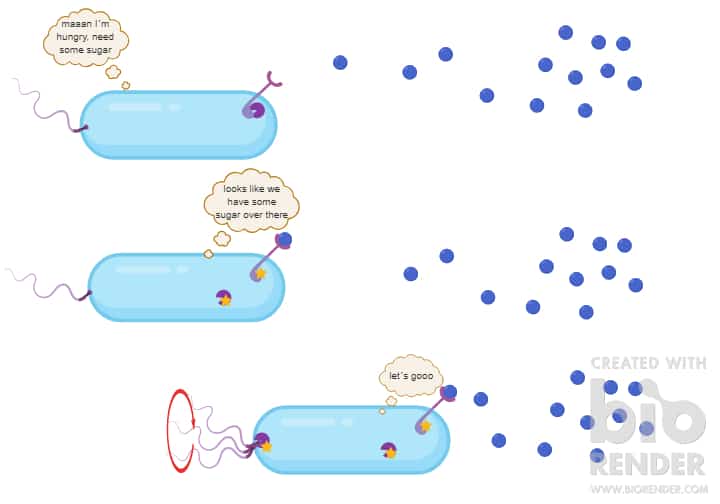
Tell your science stories with actions
From these examples, you can probably see that it comes down to using actions and verbs that your reader can relate to.
Yes, in science you might say “acquire nutrients”. However, your reader might not know what you actually mean. So, just use the word “eat”. Everyone knows what “eating” means and it still is the same as “acquiring nutrients”. Hence, stick with the language of your reader.
This is also true for other phrases that you might probably use on a daily basis. The idea is to lose that scientific jargon and use verbs and adjectives that help your audience picture your story.
This is why in the examples above, you can see the following verbs instead of their scientific equivalents:
- see, swim, seek to bind, loosen, wander, grow, fight, escape, throw, zig-zag
- hungry, happy, active, protective, invading
Everyone can imagine a player doing all these actions. Everyone knows what it means to see something or to wander around. And everyone can imagine something growing, fighting or escaping.
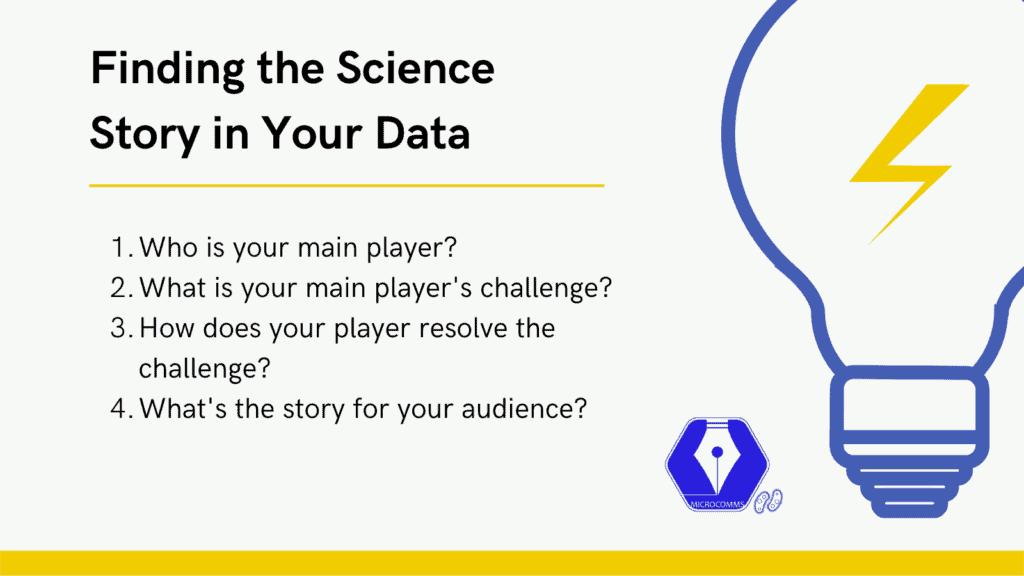
So, now when you think about how you can put your scientific data into an engaging story, try to use words that are powerful and convey actions. This will stick with your audience and help them understand your science story and thus your research project.
Improve your science communication skills by telling a story
Next time, you are struggling with your science communication project, try to wrap your scientific data into an engaging science story. Like this, you look at your research project from a completely different angle. Plus, it will be easier for your audience to engage with your research.
This storytelling aproach will help your audience understand what is going on with your player and they can learn about your research project. And this is what good science communication is all about.
